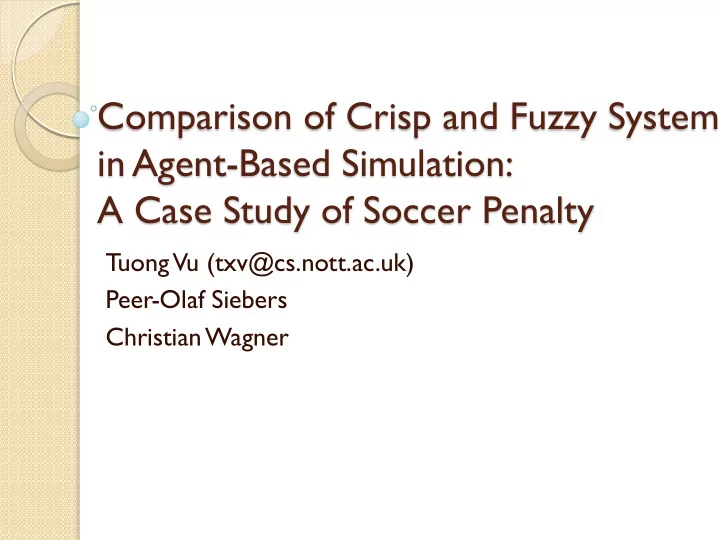

Comparison of Crisp and Fuzzy System in Agent-Based Simulation: A Case Study of Soccer Penalty Tuong Vu (txv@cs.nott.ac.uk) Peer-Olaf Siebers Christian Wagner
Outline Agent-Based Simulation Case study of “Soccer Penalty” ◦ Crisp ◦ Fuzzy Game theory of “Soccer Penalty” Discussion
Introduction The Belief-Desire-Intention (BDI) model is a reasoning architecture for a bounded rational software agent. Expand the application of the BDI software model to the area of simulating human behaviour. This paper explores the differences in using a classical crisp rule-based approach and a fuzzy rule-based approach for the reasoning within the BDI system.
Agent-Based Simulation? Simulation is an imitation of a system, which involves designing the model and performing experiment to have better understanding of the system. An agent is a very good representation for a human, because agents have following properties: ◦ Discrete entities: with their own behaviour, goals, thread of control. ◦ Autonomous: be able to adapt and modify their behaviour. ◦ Proactive: adjust action depending on agent’s internal state.
A case study of “soccer penalty” Belief Intention Desire Action
From Intentions to Actions Generate decision list • Gaze direction • Target location • Anxiety Evaluate each risk following “rule tables” with either: • Crisp system • Fuzzy system Roulette wheel selection • One final decision
Crisp System Inputs: • Gaze direction Target location • • Anxiety
Rule table 1 Displacement Anxiety Accuracy Overall accuracy (1=highest) Close Low High Close Medium High 1 Close High Medium Average Low Medium Average Medium Medium 2 Average High Low Far Low High Far Medium Medium 3 Far High Low
Rule table 2 Target area Accuracy Risk Overall risk (1=highest) Area1 Low High Area1 Medium High 1 Area1 High Medium Area2 Low High Area2 Medium Medium 3 Area2 High Low Area3 Low High Area3 Medium Medium 3 Area3 High Low Area4 Low High Area4 Medium Medium 2 Area4 High Medium Area5 Low High Area5 Medium High 1 Area5 High Medium
Fuzzy System
Implementation The model, implemented in AnyLogic 2D simulation with bird’s eye view ◦ two BDI agents (one kicker, one goalkeeper) ◦ a ball ◦ a goal. Available online at RunTheModel
Screenshots
Experimentation 1 How the percentage ◦ Crisp system: a sudden change when the anxiety of successful shots of variable is changing from one category/range to both systems vary another. ◦ Fuzzy system will be according to the affected by how fast the degree of a membership anxiety variable. function changes. 89 88 87 86 85 %goal 84 Crisp 83 Fuzzy 82 81 80 79 0 0.1 0.2 0.3 0.4 0.5 0.6 0.7 0.8 0.9 1 Anxiety
Experimentation 2 The distribution of kicker’s target locations over the 7.32m width of the goal. 3500 3000 2500 Number of times 2000 Crisp 1500 Fuzzy 1000 500 0 0 1 2 3 4 5 6 7 Target location
Risk 1 0.9 0.8 0.7 0.6 Risk 0.5 Crisp 0.4 Fuzzy 0.3 0.2 0.1 0 0 1 2 3 4 5 6 7 Target location
Risk at peak positions 1 0.9 0.8 0.7 0.6 Risk 0.5 Crisp Fuzzy 0.4 0.3 0.2 0.1 0 0 0.1 0.2 0.3 0.4 0.5 0.6 0.7 0.8 0.9 1 Anxiety
Conclusion (UKCI paper) Demonstrate the openness of BDI framework in embedding other models within its components. Crisp system can result in unwanted "preferred" actions because of sudden leaps or drops between different ranges of decision variables. Fuzzy system results have smoother transitions which results in more consistent decisions. A change from crisp to fuzzy rule based systems as the underlying reasoning model in BDI systems can provide the path to a superior approach for the simulation of human behaviour.
Game theory Goalkeeper 𝑞 𝑀 Left Center Right 𝑞 𝑆 𝑞 𝑑 = 1 − 𝑞 𝑀 − 𝑞 𝑆 Left 45 90 90 Kicker Center 85 0 85 Right 95 95 60 Against goalie pure strategies, the mixture gives payoffs: Left: 45𝑞 𝑀 + 45𝑞 𝑑 + 45𝑞 𝑆 𝑞 𝑀 = 0.355 𝑞 𝑆 = 0.561 Payoff: 75.4 Center: 90𝑞 𝑀 + 0𝑞 𝑑 + 95𝑞 𝑆 𝑞 𝑑 = 0.113 90𝑞 𝑀 + 85𝑞 𝑑 + 60𝑞 𝑆 Right:
Interpret the GT finding Kicker does better with pure Right than pure Left. Kicker should not choose pure Right strategy (60 < 75.4). Kicker choose Right with highest probability. T o counter, Keeper choose Right with highest probability.
Recommend
More recommend